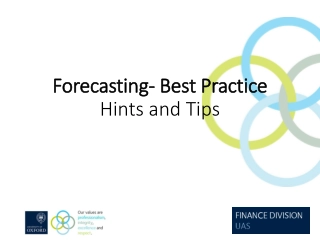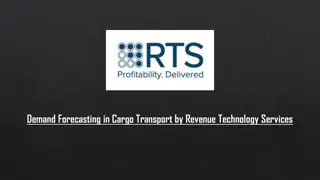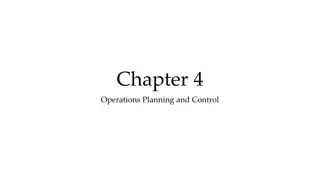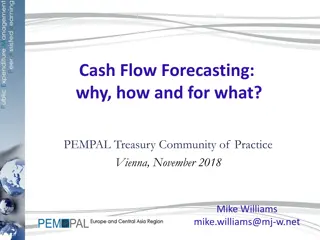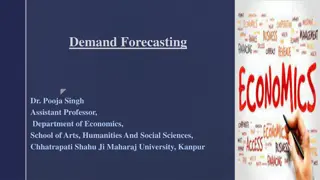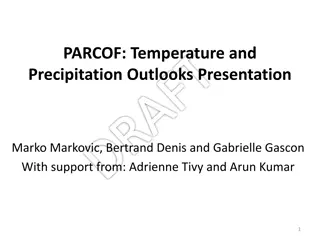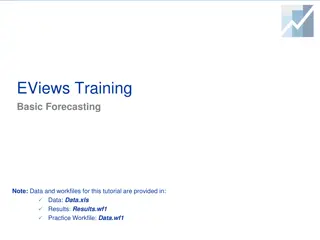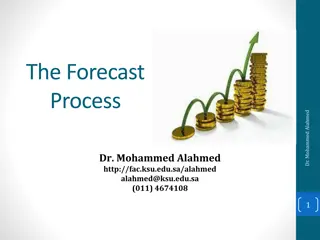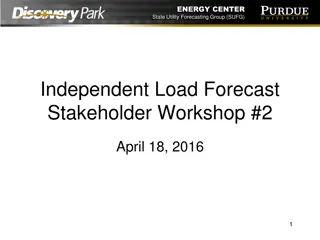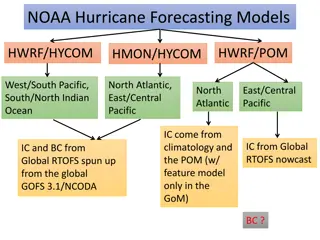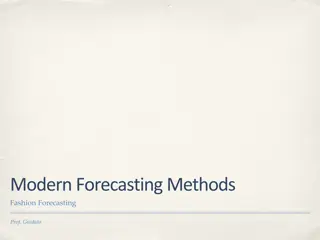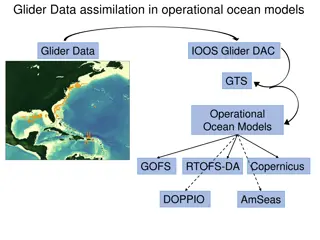Understanding Economic Forecasting with Simulation Models
Explore the concept of economic forecasting using multi-equation simulation models, focusing on producing data that follows estimated equations rather than estimating model parameters. Learn about endogenous and exogenous variables, the importance of assumptions in forecasting, and the use of simulation to find solutions for endogenous variables. Discover how the forecast command in Stata helps in solving multi-equation forecasting models through simulated data generation.
Download Presentation

Please find below an Image/Link to download the presentation.
The content on the website is provided AS IS for your information and personal use only. It may not be sold, licensed, or shared on other websites without obtaining consent from the author. Download presentation by click this link. If you encounter any issues during the download, it is possible that the publisher has removed the file from their server.
E N D
Presentation Transcript
Economic Forecasting with Multi-Equation Simulation Models Calvin Price Stata Conference 2020
Background Usual case: Look at data, produce a model equation Not here! Not interested in estimating model parameters Assume estimated equations already exist, take them as given Our case: Look at model equations , produce data Want to produce data, or simulate data, that follows the estimated equation(s) we provide We can provide multiple equations that all variables must follow simultaneously 2
Background Endogenous variables: Values for variables we solve for Values for these variables are the output of solving the model The set of behavioral equations we provide must all hold true in all solution periods Q: What value of our variables will make all equations hold true Exogenous variables: Values for variables we take as given Data values we provide, not an output from solving the model Can specify alternate values and re-solve the model, creating multiple scenarios Express some belief or assumption about policy related variables, or external variables beyond control 3
Background Exogenous variables: Harsh reality is exogenous variables can be the most important part of a forecast Not ideal but assumptions here can be most important part in producing forecasts Example from Coronavirus 2020: many central banks simply withheld forecasts given extreme uncertainty in exogenous factors Greater interest in understanding how endogenous variables react to possible scenarios of exogenous variables, rather than trying to predict one outcome of all exogenous + endogenous variables 4
The forecast- command -forecast- is a suite of commands related to solving a multi-equation forecasting model Feed in multiple equations already estimated Return data that is constructed (simulated) to satisfy all equations under all periods being forecast 5
What does simulation mean? Iterative process that searches for a solution at each time period Simulation Solving a system of equations at each point in time Finds a set of values for the endogenous variables Such that all equations are held true Algorithm Usually some variant of Gauss-Seidel Iterates until the simulated values are stable Once a solution is found, move to next time period, begin again 6
Two different solutions Solution path across time Determined by equations added to model and parameter estimates Could be explosive, oscillating, dampening, etc. depends on difference equation characteristics Model user must determine quality of forecast, good, bad, etc Solution at one point in time Determined by numerical method algorithm, iterative process 7
Toy Example Cook some data with a known relationship (n=200) Two variables, y and x2 Two estimated equations, mutual dependency (with lags) Also include one exogenous variable (x1) 8
Toy Example Use forecast- commands 9
Toy Example -forecast describe- 10
Toy Example -forecast solve- 11
Toy Example -forecast solve- 12
Toy Example -forecast solve- Every endogenous variable now has a simulated counterpart variable created, containing forecasts over the forecast horizon (and contains actuals elsewhere) Default prefix is f_ , so for endogenous variables y and x2, Stata will create f_y and f_x2 Main result: Are the original relationships maintained? We provided estimates of several behavioral equations Q: Are these relationships all maintained over the forecast period? Recall parameters from previous slide using variables y, x1, x2 Now check with the variables f_y, x1, f_x2 13
Toy Example Recall original estimated relationships (n=200) 14
Toy Example Now check over forecast period (n = 201/250) Yes, we see the (endogenous) variables contain forecast values that maintain the same relationships we fit from the estimation period Each of the multiple equations are maintained exactly, zero deviation, the variables were jointly simulated and created to have this exact property Eq 1: 15
Toy Example Now check over forecast period (n = 201/250) Yes, we see the (endogenous) variables contain forecast values that maintain the same relationships we fit from the estimation period Each of the multiple equations are maintained exactly, zero deviation, the variables were jointly simulated and created to have this exact property Eq 2: 16
Toy Example Summary We provided multiple equations already estimated Variable y was a response variable in one and an explanatory variable in another All behavioral relationships were maintained over the forecast horizon 17
Example: Forecast of US Real GDP Growth Start with 3 major components of GDP Consumption: Services Consumption: Non-Durables Investment: Business Fixed Investment 18
Example: Forecast of US GDP Given these 3 major components, can predict real GDP fairly well No surprise, this is hardly a model, more of an identity Real question: How to forecast these 3 components After that, easy to construct GDP estimate using this estimated relationship 19
Example: Forecast of US GDP Modeling choices Services consumption usually stable and resilient through cycles, shocks dissipate quickly, AR(4) Biz Investment and Non-Durables consumption more volatile, allow VAR with longer lags, and also still allow dependency on services consumption So include services consumption in the two variable VAR as exogenous 20
Example: Forecast of US GDP Modeling choices VAR with exogenous variable, not new But that variable is stillendogenousto the whole forecast model! It has it s own process that we estimated, and its forecasted values are jointly determined with the two variable VAR in every forecast period To the VAR it is exogenous, but to the entire multi-equation model it is still an endogenous variable. It is both a response variable following one estimated relationship, and an explanatory variable following another estimated relationship The forecast- command does the work of producing forecasts that maintain all behavioral relationships in all forecast periods 21
Example: Forecast of US GDP Use forecast- commands 22
Example: Forecast of US GDP Use forecast- commands 23
Example: Forecast of US GDP Use forecast- commands 24
Example: Forecast of US GDP Check results: 25
Example: Forecast of US GDP Check results: Business Fixed Investment Directionally good, miss grows larger over time 26
Example: Forecast of US GDP Check results: Consumption Non-Durables Kind of ok 27
Example: Forecast of US GDP Check results: Consumption Services Pretty good 28
Example: Forecast of US GDP Check results: Real GDP Pretty good 29
Example: Forecast of US GDP General tips on checking results: Ex post forecast Error vs actuals Sensitivity to estimated parameters / choice of equations Sensitivity to estimation period Check predictions around turning points Caution Set of equations that fit well does not mean simulated values will fit well Estimated equations with poor fit may produce simulated values that do fit well 30
Example: Forecast of US GDP General tips on checking results: Ex ante forecast No actuals to check against Sensitivity to estimated parameters / estimation period, how stable is the solution Check predictions under various scenarios of exogenous variables Compare with expected behavior and theory 31
Example: Forecast of US GDP Creating alternate scenarios: Adjusting endogenous variables Can make adjustment and force any variable to have a particular value in a particular period Exogenous variables were always adjustable, the forecast adjust- command is needed for endogenous The simulation will continue after that period and maintain all cross equation dynamics Can observe how the effect will feed through across periods, across variables 32
Example: Forecast of US GDP After adjustment: Consumption Services Suppose 0 growth in 2019Q2 33
Example: Forecast of US GDP After adjustment: Real GDP Weaker growth, as expected 34
Example: Forecast of US GDP After adjustment: Real GDP Weaker growth, as expected 35
Some History and Criticism Forecasting with large multi-equation models went in and out of popularity Famous examples: Cowles Commission, FRB-MIT-Penn, Brookings Decline in popularity in 1970s VAR models raised as a direct alternative Backlash against incredible assumptions needed to identify large models (Sims 1980) Better performance found from pure time series models (Levendis 2019) Not an either/or choice! VARs can be one of the component models in a model simulation VARs with exogenous variables not new To a VAR, exogenous variable is exogenous. To a larger model, exogenous variable has its own model. Capturing joint behavior is the extra benefit from simulation model 36
Questions? Contact: Calvin Price caprice@us.mufg.jp 37
Further Reading References Asteriou, Hall, (2011) Applied Econometrics Klein, Young, (1980) Introduction to Econometric Forecasting and Forecasting Models Levendis, (2019) Time Series Econometrics Meyer, (1980) Macroeconomics, A Model Building Approach Pindyck, Rubinfeld, (1991) Econometric Models & Economic Forecasts Sims, (1980) Macroeconomics and reality. Econometrica: Journal of the Econometric Society Data Sources FRED-QD, Vintage 2020-04 https://research.stlouisfed.org/econ/mccracken/fred-databases/ 38


